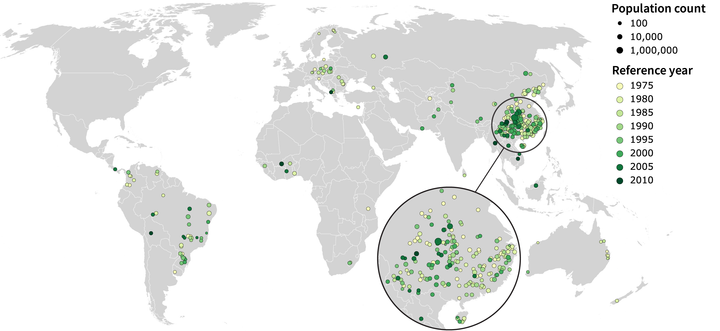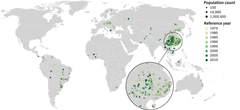EMBARGO: “Significant proportion” of world’s rural population missing from global estimates, says study
Global population datasets, crucial for decision-making by governments and institutions, may underestimate rural populations by as much as 53% to 84%, reveals an Aalto University study.

Embargo lifts: Tuesday March 18 at 06:00 EDT, 12:00 EET.
Governments, international bodies and researchers rely on global population data for resource allocation and infrastructure planning to disease epidemiology and disaster risk management. In a new study published in Nature Communications, researchers from Aalto University in Finland show the profound and systematic extent to which these datasets underestimate rural population figures worldwide.
'For the first time, our study provides evidence that a significant proportion of the rural population may be missing from global population datasets,' says postdoctoral researcher Josias Láng-Ritter from Aalto University.
‘We were surprised to find that the actual population living in rural areas is much higher than the global population data indicates — depending on the dataset, rural populations have been underestimated by between 53% to 84% over the period studied. The results are remarkable, as these datasets have been used in thousands of studies and extensively support decision-making, yet their accuracy has not been systematically evaluated,’ he says.
Population censuses are root cause for biases
Due to a lack of comprehensive reference data, previous attempts to gauge the accuracy of global population datasets have tended to focus on individual countries or urban areas.
In their study, the Aalto University researchers compared the five most widely used global population datasets*— maps that divide the planet into evenly spaced, high-resolution grid cells with population counts based on census data — with resettlement numbers from over 300 rural dam projects in 35 countries.
The study focused on population maps for the period 1975-2010, due to a lack of dam data from later years. Findings showed 2010 datasets had the least bias, missing between one-third (32%) to three-quarters (77%) of the rural population. Although global population datasets from subsequent years (2015 and 2020) have been taken into use, the team says there is strong reason to believe the latest data still misses part of the global population.
‘While our study shows accuracy has somewhat improved over decades, the trend is clear: global population datasets miss a significant portion of the rural population. With the same basic practices in place, it’s unlikely that slightly improved input data could correct for this level of bias. And even if the most recent population maps reflected reality, earlier datasets have influenced decision-making for decades and are still used to monitor change, for instance providing a distorted picture of movement over time from the countryside to urban areas,’ says Láng-Ritter.
Population censuses, the key input for the population datasets in use, are considered to be incomplete to varying degrees across regions. Not all nations have the resources for precise data collection and rural regions can be difficult to travel to, with populations spread thinly over vast areas.
Resettlement data from dam projects, in turn, provide multinational, independently gathered comparison points.
'When dams are built, large areas are flooded and people need to be relocated,’ says Láng-Ritter. 'The relocated population is usually counted precisely because dam companies pay compensation to those affected. Unlike global population datasets, such local impact statements provide comprehensive, on-the-ground population counts that are not skewed by administrative boundaries. We then combined these with spatial information from satellite imagery.”
Researchers found that the negative bias was systemic worldwide, with discrepancies particularly noticeable across datasets in China, Brazil, Australia, Poland and Colombia, where information was more readily available.
Population data critical for planning and development
With current estimates placing 43 percent of the world's 8.2 billion people in rural areas, the new findings have far-reaching consequences. Official population estimates published by the UN and the World Bank rely on the same national censuses that are the basis for the population maps.
According to Láng-Ritter, the findings suggest that the needs of people living in rural areas have been under-represented in decision-making globally compared to urban areas. Inadequate demographic data may have led to insufficient resources for health care or transport in rural regions, for example.
'In many countries, there may not be sufficient data available on a national level, so they rely on global population maps to support their decision-making: Do we need an asphalted road or a hospital? How much medicine is required in a particular area? How many people could be affected by natural disasters such as earthquakes or floods?' he says.
The necessity of the information may affect countries and regions differently, the team acknowledges, and even with inaccuracies the datasets hold crucial insight for policy and research.
‘For example here in Finland, the population data is nowadays very reliable even in rural regions, as we were the second country in the world to start keeping digital population records already in 1990. But especially in crisis-hit countries, the shift towards digital population registers could take years, even decades,' says Láng-Ritter. ‘To provide rural communities with equal access to services and other resources, we need to have a critical discussion about the past and future applications of these population maps.'
* The population datasets included in the study were WorldPop, GWP, GRUMP, LandScan, and GHS-POP.
Read the full study: Global gridded population datasets systematically underrepresent rural population, Josias Láng-Ritter, Marko Keskinen, Henrikki Tenkanen, Nature Communications, March 18, 2025. https://doi.org/10.1038/s41467-025-56906-7
Keywords
Contacts
Josias Láng-Ritter
Postdoctoral researcher, Aalto University
josias.lang-ritter@aalto.fi
p. +358 45 7837 2583
Images

Documents
Links
Information about the publisher
Aalto University is where science and art meet technology and business. We shape a sustainable future by making research breakthroughs in and across our disciplines, sparking the game changers of tomorrow and creating novel solutions to major global challenges. Our community is made up of 13 000 students, 400 professors and close to 4 100 other faculty and staff working on our dynamic campus in Espoo, Greater Helsinki, Finland.
Alternative languages
Subscribe to releases from Aalto-yliopisto
Subscribe to all the latest releases from Aalto-yliopisto by registering your e-mail address below. You can unsubscribe at any time.
Latest releases from Aalto-yliopisto
Tutkijat kehittivät uuden tavan mitata tartuttavuutta: verenmyrkytystä aiheuttava E. coli -suolistobakteeri voi levitä kuin influenssavirus11.12.2025 07:30:00 EET | Tiedote
Tutkimuksen tulokset osoittavat, että suolistossa asuvat mikrobit voivat käyttäytyä leviämisensä puolesta kuin virukset. Uusi malli tarjoaa keinon vertailla antibioottiresistenttien bakteerikantojen leviämistä populaatiossa.
Älykkäät tekstiilit uudistavat käsityksemme materiaaleista – ja lajienvälisestä viestinnästä10.12.2025 12:45:00 EET | Tiedote
Euroopan tutkimusneuvosto ERC:n rahoituksen saanut PAST-A-BOT-tutkimushanke kehittää pehmeitä, älykkäitä tekstiilejä, jotka voivat tulevaisuudessa toimia pelastusrobotteina, ääntä aistivina maataloustekstiileinä tai avustavina vaatteina – ja samalla uudistavat tavan, jolla ajattelemme materiaalitutkimusta.
Tuloerot kasvaneet lähes puolella maailman väestöstä – aiempaa tarkempi aineisto paljastaa myös alueellisia onnistumisia5.12.2025 12:00:00 EET | Tiedote
Uusi tutkimus tarjoaa maailmanlaajuisesti kattavimman kartoituksen siitä, miten maiden sisäiset tuloerot ovat muuttuneet kolmen vuosikymmenen aikana. Tulokset vahvistavat, että yli 3,6 miljardin ihmisen asuinalueilla tuloerot ovat kasvussa – mutta aineisto paljastaa myös paikkoja, joissa kuilua on onnistuttu kaventamaan.
Subnational income inequality revealed: Regional successes may hold key to addressing widening gap globally5.12.2025 12:00:00 EET | Press release
A new study visualises three decades of income inequality data, the most comprehensive worldwide mapping to be done at a subnational level. Confirming worsening income inequality for areas with over 3.6 billion inhabitants, it also reveals hidden ‘bright spots’ where policy may be closing the gap.
Tutkimus: Puu on betonia edullisempi rakennusmateriaali, kun myös päästöt hinnoitellaan3.12.2025 07:27:00 EET | Tiedote
Myrskylän hirrestä rakennetun koulun ja liikuntahallin kustannuksia verrattiin betonivaihtoehtoon – ja puu osoittautui selvästi edullisemmaksi, kun päästöille annettiin rahallinen arvo.
In our pressroom you can read all our latest releases, find our press contacts, images, documents and other relevant information about us.
Visit our pressroom